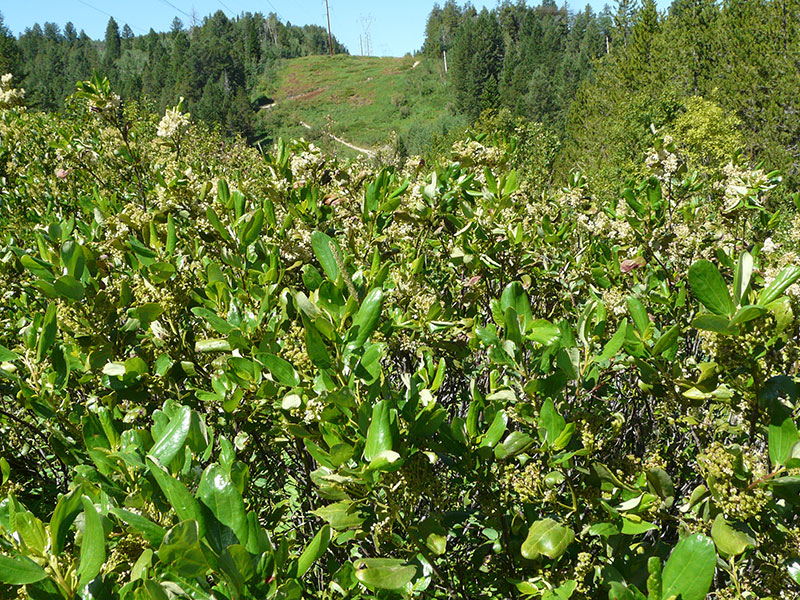Ceanothus velutinus / snowbrush
- waist-high, exposed evergreen shrub
- aromatic in hot weather or when leaves are crushed
- shiny (sticky) green leaves, ca. 3″; 3 prominent veins
- 4″ clusters of teeny white/cream flowers
- in disturbed areas, particularly burned areas
Also known as: snowbrush ceanothus, red root (reflecting the color of the roots’ inner bark), tobacco brush, mountain balm, buckbrush, cinnamon bush, sticky laurel, varnish-leaf ceanothus
Snowbrush is an evergreen woody shrub, the only waist-high shrub meeting this description in the region. With its multiple stems per plant, it forms dense round-topped colonies – as much as 30 feet across – that are easy to walk around, and nearly impossible to walk through. This is especially fine for animals and birds seeking safe shelter.
The leaves of snowbrush are up to 3 inches long, shiny (and sticky) on the top and pale green and velvety on the bottom. The leaf margins are finely toothed. All sources on the web will also mention that the leaves have 3 prominent veins, a feature that is, rather unusually, visible from either side. The leaves emit a sweet aroma in warm weather or when crushed. New leaves grow with bud break in early Spring; expansion continues until early July.
The white flowers of snowbrush appear in pyramidal clusters, 2 to 4 inches long, and plentifully throughout the shrub. The clusters have been called “panicle-like”. The individual flowers are teeny, ca. 1/8 inch across, and creamy white. The clusters are reminiscent (close your eyes and go with this) of patches of light snow on the leaves, hence the name, snowbrush. Flowering begins in late June (in the Valley) and goes on until early August. All that depends, of course, on elevation.
Flowering is followed by formation of small capsules that explode to eject their seeds. The fruits are desired by numerous bird species. The seeds are notable for persisting in the soil seed bank for over 200 years, and germinating after fire (especially hot fires) or other very harsh treatment. Interestingly, the plant itself is relatively short lived, beginning to deteriorate at ca. 15 years. Consequently, it is often found where fire has come through relatively recently, and just after a fire, there may be thousands of seedlings.
In early life, seedlings may compete with fireweed for space, but the perennial, spreading life style of snowbrush results in the fireweed being forced out in 7-10 years. However, snowbrush doesn’t come up as much after low-intensity prescribed burns. Experimental studies really have shown that the high intensity is important.
The root system of snowbrush is also interesting, and important. The shrub has a large taproot and a deep, spreading root system. This gives it a high degree of drought resistance. This is reflected in its habitat choice… open rocky hillsides and partially shaded forests, often on dry mountain or steep canyon slopes.
Snowbrush is also very good browse for many mammals because it has a very high nutrient content, even on really poor soils. This is due to its ability to fix nitrogen from the air; useable nitrogen is deficient in most soils, so this is a real advantage to snowbrush. The fixation chemistry takes place in root nodules by nitrogen-fixing Frankia ceanothi bacteria. Whereas in some species, the fixed nitrogen is released into the soils and nourishes other plants, in this case, most of the nitrogen remains in the snowbrush bushes. The result is that nodulated snowbrush seedlings produce about 2.5 times the dry weight of non-nodulated seedlings (in poor soil).
| Color | |
|---|---|
| Family | |
| Blossom size | |
| Inflorescence size | |
| Inflorescence type | |
| When? | |
| Where? |



